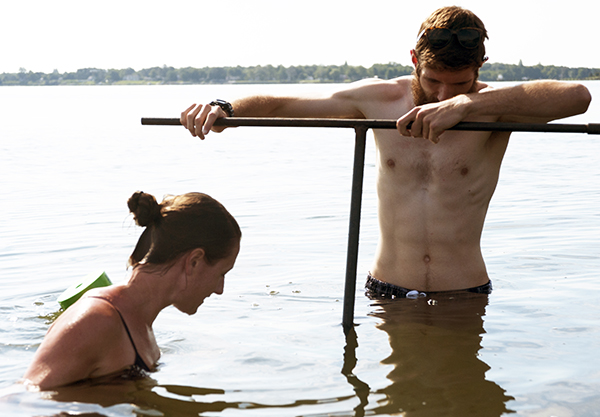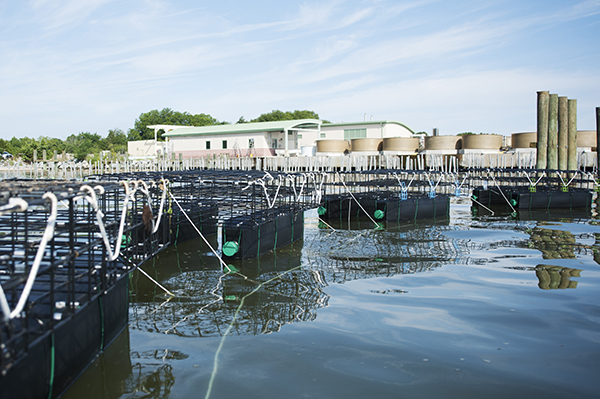Knauss legislative fellowships in Congress help build careers — and they're fun and educational. See our video and fact sheet for details.
Testing What Works in Oyster Aquaculture: Planting Gear in the Choptank
The Horn Point Laboratory Oyster Hatchery is conducting research to help Maryland oyster growers figure out what type of equipment best suits their business needs. Interns at the hatchery in Cambridge, Maryland, helped to anchor new types of oyster-growing gear along the Choptank River in the summer of 2016. The hatchery uses the gear to evaluate how different types of growing equipment influence size, shape, and other commercially important characteristics of farmed oysters. Some of the growing systems at the farm float on the surface; others sit below the surface or just above the bottom. The growing systems shown in these photos are just some of those currently being evaluated at the hatchery.
 |
|
This floating oyster growing cage will be outfitted with six mesh bags containing oysters. In this orientation, the cages (and oysters) are submerged, allowing the bivalves to feed. But as the bags become fouled with algae and other marine organisms, the whole rig can be flipped over to expose the contents to the sun’s rays. Periodic exposure to the sun can kill many fouling organisms. Photo: Daniel Pendick |
 |
|
Sam Moxey (left) and Tom Butler, interns at the Horn Point Laboratory Oyster Hatchery, prepare the growing cages for deployment in a tidal area on the lower Choptank. This location provides both a rich source of food for oysters but also a relatively protected environment, with gentle currents and small to moderate wave motion. Photo: Daniel Pendick |
 |
|
The team shepherds floating oyster-growing growing cages out to a spot where they will be clipped to a metal post secured to the river bottom. The pilings in the background at left are part of a different type of oyster-growing system. Photo: Daniel Pendick |
 |
|
In its oyster-growing orientation, the pontoons supporting the cages sit above the water line. But notice the large green caps at the end of the floats: these can be opened to allow water to enter the floats and sink the cages to the bottom during rough weather. Photo: Daniel Pendick |
 |
|
Lines of floating oyster-growing cages are tethered to steel rods, each with a corkscrew-like end rotated into the river-bottom sediment to secure it. Oyster Hatchery intern Tom Butler (right) twists an auger into the river bottom, assisted by Shannon Hood, a staff member at the hatchery who manages the demo farm. Photo: Daniel Pendick |
 |
|
The floating oyster-growing cages are attached to each other by nylon rope. When anchored at both ends to the river bottom, the lines of floats can withstand fairly rough wave action, although in this spot they are semi-protected. Photo: Daniel Pendick |
 |
|
As more cages are moored in place, an oyster-production flotilla begins to take shape at the demonstration farm. Photo: Daniel Pendick |
 |
|
As the morning’s work winds down, the team members pause for a group portrait. Pictured from left to right are interns Tom Butler, Chelsie Bateman, and Sam Moxey. Shannon Hood, project manager for the oyster demo farm, sits at right. Photo: Daniel Pendick |
For more information about the Horn Point Oyster Hatchery demonstration farm, contact Shannon Hood.
Photo, top left: Three summer interns and one full-time employee at the Horn Point Laboratory Oyster Hatchery, University of Maryland Center for Environmental Science (UMCES), prepare short lengths of nylon rope needed to assemble floating oyster-growing cages at the demonstration farm. Pictured, from left to right, are: Chelsie Bateman, Tom Butler, Shannon Hood (project manager of the oyster equipment demonstration farm project), and Sam Moxey. Photo: Daniel Pendick.
See all posts from the On the Bay blog







